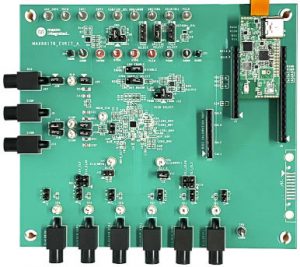
The chip, MAX86178, does this with three channels, one each for: photodiodes (optical PPG for blood oxygen and heart rate), voltages (electrocardiogram (‘ECG’ or ‘EKG’) and alternative heart rate) and bio-impedance (‘bio-z’ for respiration rate)
Optical PPG (Photoplethysmography) and ECG timing can be synchronised for ‘derived health metrics’, according to the company.
PPG data acquisition system supports up to 6 LEDs and 4 photodiode inputs. The LEDs are programmable from two 8bit LED drivers.
The receive path has two read-out channels, each with its own 20bit ADC (112dB signal to noise ratio). Ambient light cancellation is included, claimed to be better that 90dB at 120Hz with averaging.
The ECG channel is designed to meet IEC 60601-2-47 ambulatory monitoring compliance requirements. It has anti-aliasing low-pass filtering, internal lead biasing, right-leg drive, and calibration voltages for built-in self-test.
15.6 effective bits are claimed at 6nVrms (0.05Hz – 40Hz), with 230fArms input noise (0.05Hz – 40Hz +25°C). The differential signal chain has a CMRR of over 110dB at 50Hz and 60Hz. Differential input range is ±1.3V (1.8V typically).
The BioZ receive channel has EMI filtering , calibration and several modes for generating input stimulus: balanced square-wave source/sink current, sine-wave current, and both sine-wave and square-wave voltage stimuli (16Hz to 500kHz). 17 effective bits are claimed for the receive channel.
Overall, the chip will work over -40°C to +85°C and comes in a 2.8 x 2.6mm wafer-level package. It shuts-down to 0.5μA (typ).
A 256 word FIFO is provided for the three channels.
There is an evaluation kit (photo above).
Sadly, the MAX86178 and eval board datasheets are only available after signing an NDA.
Maxim integrated was recently bought by ADI.